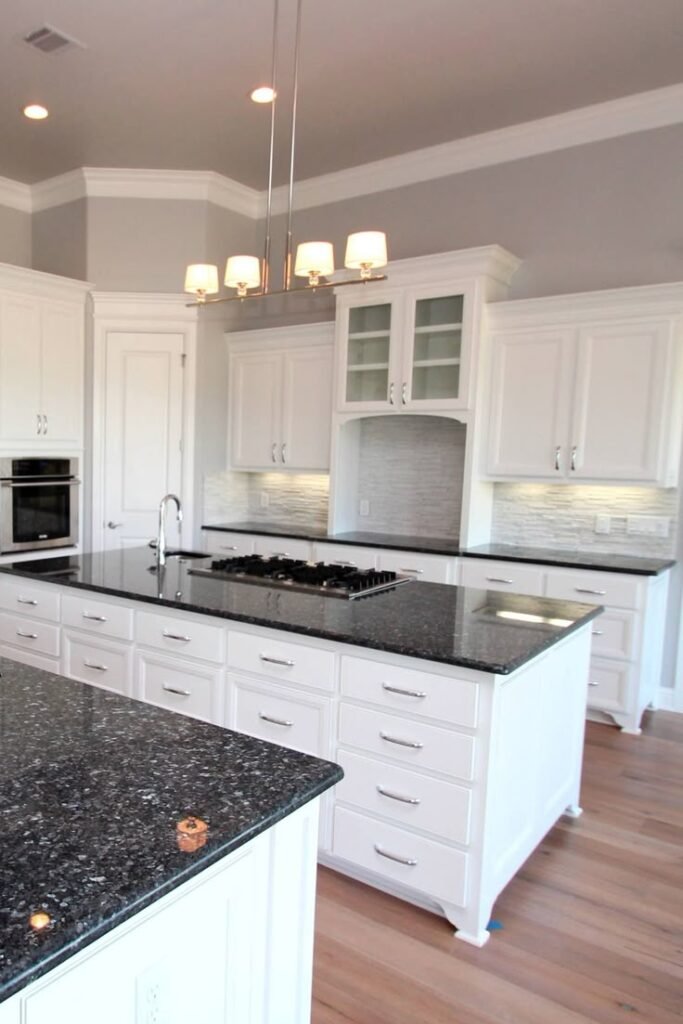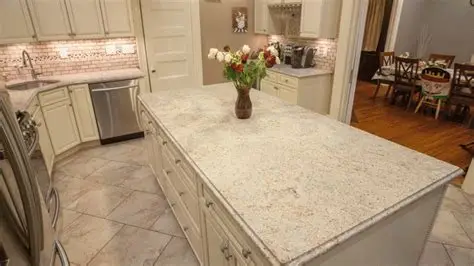Granite is a natural stone with a protective sealer. Most disinfecting wipes (including many Clorox® formulas) contain strong surfactants, quaternary ammonium compounds (quats), fragrances, and a pH that can degrade sealers, leave a dull film, or create streaks—especially on polished black granite countertops. Below is a complete guide to why wipes miss the mark, how to safely clean and disinfect granite, and pro tips to keep your investment looking showroom-new.

Why Clorox Wipes Aren’t Granite-Friendly
Granite’s durability comes from its geology—interlocking crystals of quartz, feldspar, and mica—but the finish you see is the combination of dense stone + factory/fabricator polishing + a penetrating sealer. Wipes can upset that balance.
What’s inside common disinfecting wipes
- Quats (powerful disinfectants) that can leave a persistent residue.
- High-alkaline or low-acid formulations (depending on product) that aren’t pH-neutral.
- Surfactants & fragrances that streak, haze, and attract soil.
- Solvents that can prematurely wear or blotch color enhancers and sealers.
How that chemistry shows up on your counters
- Sealer breakdown: Granite becomes more absorbent, so coffee, oil, or wine stains set faster.
- Finish dulling & haze: The glossy polish looks “cloudy,” most visible on darker stones.
- Sticky film & streaks: Especially under bright kitchen lighting or on large islands.
- Edge/fixture damage risk: Overspray can affect grout, wood finishes, and metal trim.
Curious about bleach specifically? Get the detailed do’s and don’ts here: Can you use bleach on granite countertops?

Granite Basics (and why care products matter)
- Natural vs. engineered granite: True granite is natural stone. Engineered “granite” is a misnomer—most “engineered stone” slabs are quartz composites. Granite and quartz respond differently to chemicals.
- Characteristics of granite: Hard, heat tolerant, and microporous. That porosity is why sealing matters for clean granite countertops in busy kitchens.
- Finishes behave differently: Polished shows streaks fastest; honed and leathered are a bit more absorbent and can darken where oils sit.
Safer Daily Cleaning Routine (No Wipes Required)
You don’t need harsh chemicals to keep granite kitchen countertops sanitary.
- Dry wipe grit and crumbs with a clean microfiber towel.
- Spritz a pH-neutral stone cleaner (or warm water + a drop of mild, dye-free dish soap).
- Wipe in overlapping passes from backsplash to edge.
- Rinse with clean water (distilled water is great for dark stones).
- Buff completely dry with microfiber for that crisp, reflective shine.
This routine keeps white granite countertops bright and helps grey granite and dark finishes avoid streaks.
How to Disinfect Granite the Right Way
If you want true disinfection without risking the finish:
- 70% isopropyl alcohol: Spray lightly, allow a 2–3 minute dwell, then rinse with clean water and buff dry.
- Stone-safe disinfectants: Choose products labeled safe for natural stone countertops (check the fine print).
- Avoid daily disinfecting: Clean daily; disinfect as needed (post-illness, raw poultry mishaps, etc.).
What about using wipes “just sometimes”? Even occasional use can haze a polished surface. If you must use one in a pinch, immediately rinse thoroughly and buff dry—then recheck your sealer (see below).
Stain & Spill Playbook (Stone-Safe Fixes)
Different spills need different strategies—no wipes required.
Oil-based stains (olive oil, butter, cosmetics)
Use a baking soda + water poultice (peanut-butter thickness). Apply, cover with plastic wrap (poke a few holes), wait 24–48 hours, remove, rinse, and buff dry. Repeat if needed.
Organic stains (coffee, tea, wine, berries)
Swap the liquid for 3% hydrogen peroxide (with baking soda). Same poultice method.
Metal/rust
Use only stone-safe rust removers and spot-test first, or call a pro.
Sealing Granite: The Other Half of “Clean”
A good sealer is your safety net—especially for white and light granite and for honed surfaces.
The 60-second water test
Place a teaspoon of water on the counter:
- Darkens within 5–10 minutes? Time to reseal.
- Beads for 30+ minutes? You’re protected.
Resealing tips
Clean → let dry fully → apply a penetrating sealer per label → buff off all excess before it dries → allow the full cure (often 24 hours) before heavy use. Resealing frequency varies by stone color/finish and household traffic.
Budget note: Factoring resealing into your maintenance plan helps protect your granite countertop cost investment and preserves value compared with other surfaces in a natural stone countertop comparison.
Finish-Specific Advice
Polished granite (common in showrooms)
- Least porous; most mirror-like.
- Shows streaks from residues quickly—always buff dry.
Honed granite (matte/satin)
- Slightly more absorbent; fingerprints and oils are more visible.
- Keep up with sealing and use distilled-water rinses to minimize mineral haze.
Leathered/antiqued granite (textured)
- Holds crumbs and oils in micro-texture.
- Use a soft nylon brush with a pH-neutral cleaner, rinse, and towel dry.
Granite vs. Quartz, Marble & Soapstone: Cleaning & Durability Snapshot
- Granite vs quartz countertops: Both dislike harsh cleaners. Quartz’s resins can discolor with strong solvents and heat; granite’s sealer can degrade with harsh chemistry. Granite is more heat tolerant; quartz is more uniform in pattern and color.
- Granite vs marble (pros and cons): Marble is more sensitive to acids and easily etched. Granite is typically tougher and lower maintenance.
- Granite vs soapstone durability: Soapstone is dense and non-porous but softer (can scratch). Both clean well with mild products; soapstone develops a patina (often oiled).
If You Already Used Clorox Wipes—What Now?
- Rinse thoroughly with clean water to remove residues.
- Buff dry to restore shine and check for haze.
- De-film (if needed): Use a stone-safe, pH-neutral cleaner and a clean microfiber; avoid abrasives.
- Re-test sealer with the water test the next day.
- Reseal if water no longer beads as before.
For persistent cloudiness, a stone pro can lightly repolish the surface or deep-clean and reseal.
Buying, Installing & Maintaining Granite: Practical Tips
- Where to buy granite countertops: Compare local countertop showrooms, fabricator yards, and wholesale granite suppliers for the best slab selection and affordable granite countertop options.
- Pairing granite with cabinet colors & backsplash designs: Bring door samples and backsplash tiles to the slab yard; daylight photos matter for granite backsplash designs.
- Transport & installation: Reputable installers use pro-grade handling equipment to protect slabs and finished tops. See jobsite solutions at Toolrange and heavy-lift attachments like the Aardwolf Forklift Boom FB1-2720 that pros rely on.
- Long-term care: A light daily routine + periodic sealing granite keeps surfaces brilliant for years.
FAQs About Wipes & Granite
Are there Clorox® wipes that are safe for granite?
Unless the label explicitly says safe for natural stone, assume no. Many disinfecting wipes (even “gentle” ones) leave films or impact sealer performance.
Do I need to disinfect daily?
Routine cleaning removes biofilm; targeted disinfection (with 70% isopropyl alcohol) is enough for high-risk moments.
Can I use glass cleaner instead?
Ammoniated glass cleaners can haze stone. Use stone-specific glass/shine products or stick to pH-neutral cleaners and a microfiber buff.
How often should I reseal?
Depends on color, finish, and traffic. Many households reseal annually or every 1–2 years. Use the water test to decide.
The Bottom Line
Clorox® wipes are convenient—but not the best choice for granite. Their chemistry can degrade sealers, dull the polish, and leave residue. For long-lasting, beautiful granite stone in kitchens and baths, keep it simple:
- Daily: pH-neutral stone cleaner → rinse → buff dry.
- Disinfect as needed: 70% isopropyl alcohol, brief dwell, rinse, dry.
- Stains: Baking-soda poultice tailored to oil vs. organic spills.
- Protect: Reseal when the water test says it’s time.
Follow these steps and your countertops will keep their depth, clarity, and value—outshining many alternatives in the ongoing granite vs quartz countertops debate.
Helpful Resources
- Pro’s and con’s of bleach on stone: Can you use bleach on granite countertops?
- Jobsite handling & transport solutions: Toolrange • Aardwolf Forklift Boom FB1-2720

